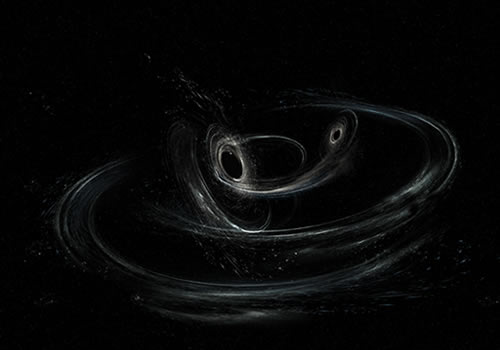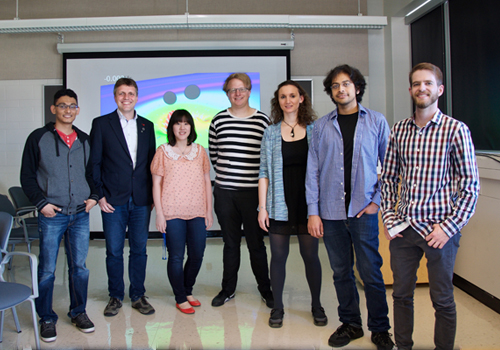The latest major announcement from the Laser Interferometer Gravitational-wave Observatory (LIGO) marks the third time gravitational waves — ripples in space and time — have been detected. The discovery paves the way to a wealth of information about black holes and other unknown phenomena and would not have been possible without the key contributions of a team of U of T astrophysicists.
LIGO made the first-ever direct observation of gravitational waves in September 2015, followed by a second detection in December 2015. As was the case with the first two detections when they were reported last year, the waves were generated when two black holes collided and merged into a larger black hole.
The latest new-found black hole has a mass about 49 times that of our sun and, at 3 billion light-years away from Earth, seems to be the farthest away to date. The black hole involved in the first detection was 62 times the mass of the sun and 1.3 billion light years away, while the one that figured in the second detection was 21 times the sun’s mass and 1.4 billion light years away.
“With this latest detection of gravitational waves, we continue to learn that colliding black holes come in a variety of masses,” said Harald Pfeiffer, associate professor and Canada Research Chair in Gravitational Wave Astrophysics and Numerical Relativity, at the Canadian Institute for Theoretical Astrophysics (CITA) in the Faculty of Arts & Science at U of T. “These new black holes are the second-most massive stellar mass black holes ever detected, second only to our first LIGO discovery.”

This third detection —called GW170104 and made on January 4, 2017 — is described in a new paper published today in Physical Review Letters authored by the LIGO Scientific Collaboration (LSC), a body of more than 1,000 international scientists who perform LIGO research together with the Europe-based Virgo Collaboration.
In all three detections, each of LIGO’s twin detectors — one in Livingston, Louisiana and one in Hanford, Washington — picked up gravitational waves resulting from the tremendously energetic mergers of black hole pairs. These collisions produce more power than is radiated as light by all the stars and galaxies in the universe at any given time.
“The fact that this latest detection is so far away enables us to test Einstein’s equations more precisely than ever before, and to perform different tests of Einstein’s equations for the very first time,” said Pfeiffer.
Pfeiffer, who is also a Fellow of the Canadian Institute for Advanced Research (CIFAR), leads a team of seven researchers at U of T that constitutes Canada’s contribution to the LIGO project. The team had originally been largely responsible for performing simulations of black hole-collisions on high-performance supercomputers, and producing the gravitational waveforms – the shapes of the signals – that LIGO searches for. Having doubled in size over the past year, the team now includes researchers taking leading roles in estimating the masses and spins of the colliding black holes.

“Knowing more about the ways black holes spin will teach us how binary black holes form and whether or not the rotation of each are aligned with their orbits,” said Pfeiffer.
There are several models that explain how binary pairs of black holes can be formed, and the ongoing detections of gravitational waves will help scientists hone in on the best ones.
The new LIGO data points to the possibility that at least one of the black holes may have been non-aligned compared to the overall orbital motion. While more observations with LIGO are needed to be definitive these early data offer clues about how these pairs may form.
Heather Fong, a PhD candidate in the Department of Physics and member of Pfeiffer’s team at CITA, has played a key role in the development of the gravitational waveforms – the shapes of the signals – that LIGO searches for. Though she was instrumental in the process of simulating collisions of black holes which led to the first two detections, this latest event is particularly exciting for her, having recently spent three months at LIGO’s Hanford site.
“I arrived just a week after we made this latest detection. Because I am mainly involved with the data analysis effort, it was amazing to be able to work on the experimental side and interact directly with the detector,” said Fong. “The time I spent there gave me a great deal of insight into how the LIGO detectors work, as well as a profound appreciation for how they’re able to be as sensitive as they are.”
Pfeiffer believes that more results may also allow scientists to identify other unknown phenomena that are yet to be identified.
“The other really important source of gravitational waves that everybody is eagerly waiting for are binary pairs involving neutron stars, whether they be two neutron stars or a black hole colliding with a neutron star,” he said. “Either way, these detections are continuously proving Einstein’s century-old theory of relativity is correct. And they are doing so with objects we didn’t know existed before LIGO detected them.”
With files from LIGO.

